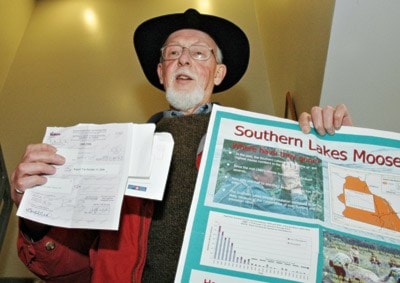Peter Percival, 68, is protesting the decline of the Southern Lakes moose population in his quiet way.
He doesn’t yell or wave a placard. He’s armed only with his permit to shoot a moose.
He’s giving it back.
In 1987, the Southern Lakes moose population, south of Whitehorse, was estimated to be 1,800. Today, the population is believed to be about 800.
That’s a 44 per cent decline.
Percival pads down the maze-like hallways of the Yukon Environment department headquarters. It’s 11 a.m. on Thursday, and he has a meeting with the deputy minister Kelvin Leary.
He waits quietly. Far more noisy than Percival are the gaggle of reporters in tow.
Soon, Leary emerges from an office and looks over the crowd.
“I see you’ve brought along an entourage,” he says.
“I didn’t bring them along. They came,” says Percival.
Percival hands over his hunting permit.
“In good conscience, there’s just no way I can hunt a moose,” he says.
“I hope you don’t think I’m just an unsuccessful hunter,” he adds.
The two enter a boardroom, for a private talk away from reporters.
The subject of their conversation is a complicated one: why has the moose population declined, and what is being done about it?
Thirty years ago the Southern Lakes region teemed with moose. The area was a ‘breadbasket’ for many.
That was before snowmobiles and all-terrain vehicles became popular.
Suddenly, remote areas that could only be accessed by several days of hard hiking or skiing were only an hour’s ride away.
Moose hunting became easier.
The ease with which hunters can now reach moose is believed to be a major reason for the population’s decline, says Rob Florkiewicz, a biologist with the Yukon government.
Overhunting is believed to be a big reason for the decline.
Few moose have been shot by licensed hunters since 1988, when the Yukon government began imposing a limit of 11 moose-hunting tags to the region.
The continued decline of the moose is linked to aboriginal hunting, according to a government-funded poster made in 2004.
“Since 1989, fewer than five moose per year have been taken by licensed hunters,” says the poster titled Southern Lakes Moose, which was prepared for public release. “We do not know how many moose were taken by First Nation hunters over that time, but local information suggests that it has been high in some years.
“The Southern Lakes moose population continues to be low, likely because of the combination of over-hunting and high predation rates.”
Government projections show that, if hunting continues unabated, the number of moose will continue to dwindle.
But if the First Nation subsistence hunt is limited, the moose population could rebound to about 2,000 animals in eight years, states the poster.
First Nations bristle at the accusation they are to blame for the moose decline (see letter on page 10).
Loss of habitat from housing developments, forestry and mining activity are other reasons for the moose decline, they say.
And the aboriginal hunt is being voluntarily restricted, they say.
It is still not clear how many moose are being shot by First Nations in the area.
The government’s proposal to limit aboriginal hunting, prepared in February 2004, was never acted upon for fear of disrupting the negotiation of First Nation land claim agreements.
The last of these deals to be negotiated with the six First Nations that hunt the Southern Lakes moose was completed in 2006.
These land claim agreements changed wildlife management rules.
Rather than having the Yukon government in charge of managing the moose, there are now nine governments at the table: six First Nations, the BC government, Environment Canada and the Yukon government.
The Southern Lakes Wildlife Co-ordinating Committee, made up of representatives from these groups, is supposed to begin work this winter on a management plan for the moose.
But if the process to limit hunting of moose in Southern Lakes takes much longer, the Yukon government should consider placing its own limits on the aboriginal hunt, says Percival.
Land claims include provisions to limit the aboriginal hunt for valid conservation reasons.
But that’s not an option, says Florkiewicz.
First Nation hunters need to be onside with any hunting restrictions for them to work, he says.
He points to voluntary restrictions on caribou hunting recently undertaken by First Nations in Southern Lakes.
It worked. Caribou numbers rebounded from a low of 300 to about 1,300 today.
Even if the government wanted to be heavy-handed and impose restrictions on the native moose hunt, it would take two years for new regulations to come into force, says Florkiewicz.
And imposing such rules would run counter to the spirit of land claims, which hold that First Nations should be treated as equals to other levels of government, he says.
Ten minutes later, Percival emerges from his meeting.
How does he feel?
His response, as usual, is subdued.
The Yukon government will push to have an agreement put in place, he says, referencing his talk with Leary.
A management plan could be ready as early as the spring of 2009, says Percival.
“That’s a good intention,” he says. “Will they be successful? Will they carry it through?
“I hope so.”
